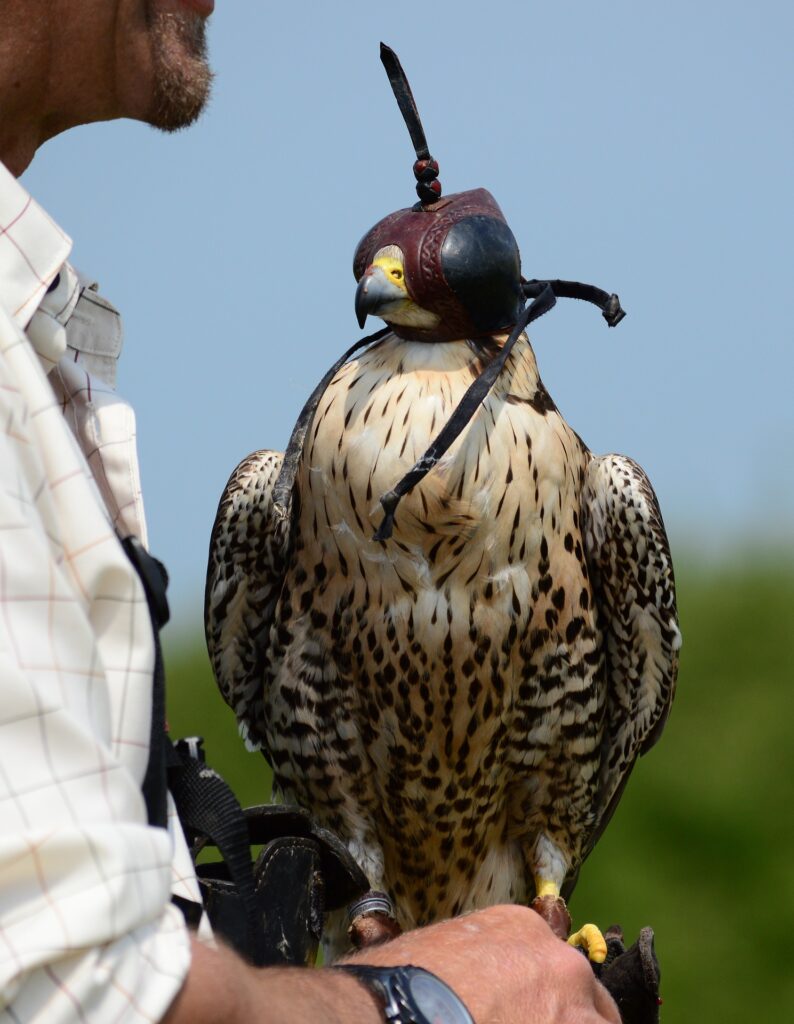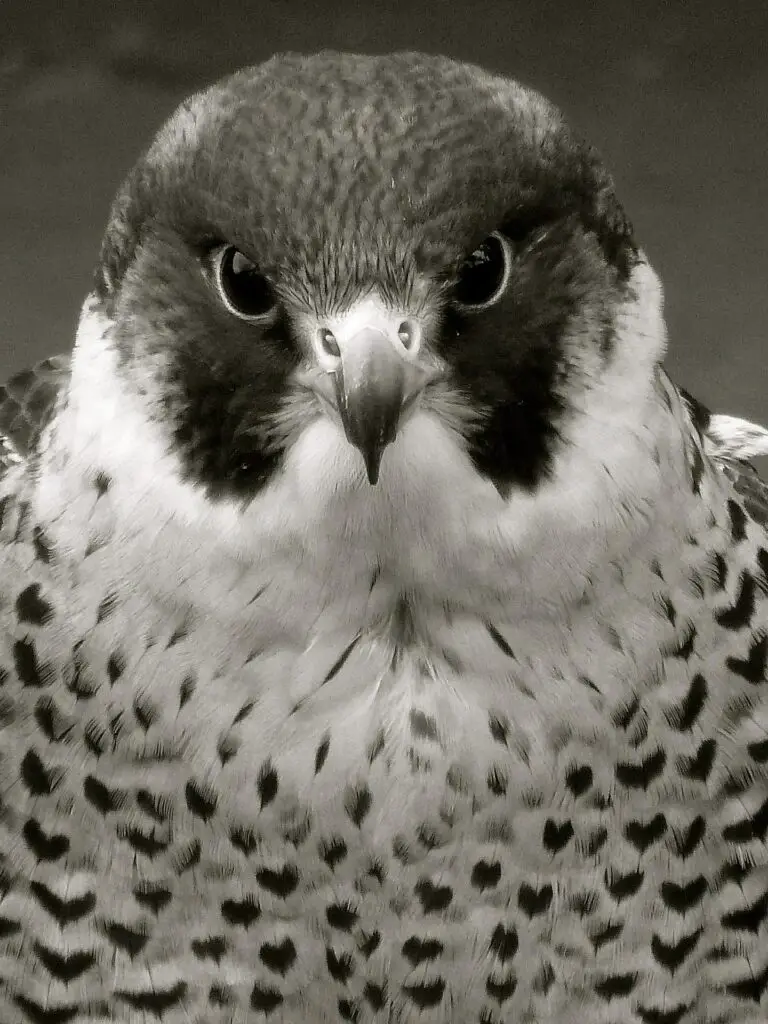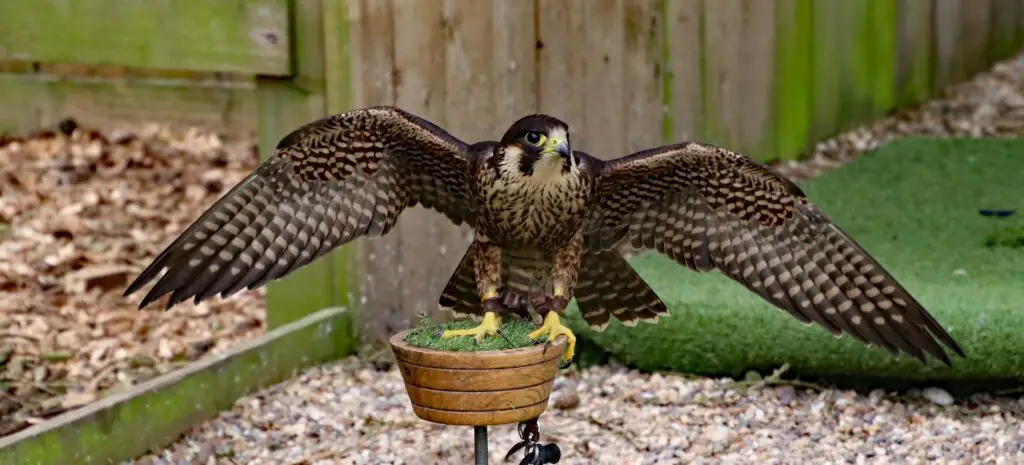Training a Peregrine Falcon is no easy task, but with patience, dedication and the right techniques, it can be done successfully. In this step-by-step guide, we will cover the steps I took when training my own Peregrine Falcon, named Swift. From choosing the right Falcon to basic falconry techniques and advanced training methods, this guide will provide you with all the necessary information to train your Peregrine Falcon. So let’s get started!
Peregrine Falcon Training Basics
When training a Peregrine Falcon, it’s essential to establish a strong foundation in basic falconry techniques. Firstly, it’s crucial to create a bond with the Falcon through consistent positive reinforcement. Using a gentle approach and rewarding desired behaviours with food treats helps build trust and cooperation.
Next, mastering the art of falconry equipment is vital. Understanding how to properly fit and maintain jesses, anklets, and leashes ensures the safety and security of both the Falcon and the Falconer. It’s essential to check equipment regularly for any signs of wear and tear to prevent accidents during training sessions.
Practising basic falconry commands such as ‘come,’ ‘perch,’ and ‘hoop’ lays the groundwork for more advanced training. These commands help in controlling the Falcon during flights and exercises. Consistent repetition and positive reinforcement are key to ingraining these commands into the Falcon’s behaviour.

Understanding Peregrine Falcon Behaviour
Understanding Falcon Behavior involves observing and interpreting subtle cues and body language to accurately anticipate the bird’s next actions. Falcons communicate through their behaviour, and as trainers, it’s crucial to decode these signals to build a strong bond and achieve successful training outcomes.
Here are four key aspects to consider when understanding falcon behaviour:
- Body Language: Pay close attention to how the Falcon positions its head, wings, and tail. These subtle postural adjustments are a fascinating window into the bird’s emotional spectrum, ranging from heightened alertness and assertiveness to moments of serene calmness and deep relaxation. By keenly observing and interpreting these nuanced body language signals in the Falcon, one can gain valuable insights into its present state of mind and underlying intentions.
- Vocalizations: Like many other birds of prey, peregrines use a complex system of vocal cues to express their needs and emotions. Their calls, from sharp cries to gentle sounds, show hunger, contentment, and other states. Understanding these cues enriches training and strengthens the bond between trainers and falcons. This knowledge helps trainers respond well, creating a more productive and empathetic interaction during sessions.
- Feeding Habits: Peregrine Falcons are opportunistic hunters whose natural diet is mainly comprised of birds. As such, they exhibit feeding behaviour that involves tearing off pieces of meat with their sharp talons and beaks, followed by gulping it down in sizable portions. Trainers should observe this behaviour to understand how much food to offer during training sessions and ensure the bird maintains a healthy weight.
- Flight Patterns: Studying the Falcon’s flight behaviour can provide insightful data regarding its mood, energy levels, and preparedness for training sessions. By observing the nuances of its aerial movements, trainers can tailor exercises to suit the Falcon’s current state, ensuring optimal performance and well-being.
Selecting the Right Training Environment
To optimize training outcomes when working with a Peregrine Falcon, it is important to find an appropriate training environment, which is crucial for fostering effective communication and establishing a strong bond. When choosing a training environment for a Peregrine Falcon, it’s essential to consider factors such as noise levels, distractions, and safety. Falcons are highly sensitive to their surroundings, so selecting a quiet and controlled space is paramount. This environment should be free from loud noises that could startle the Falcon and cause stress, hindering the training process.
I always ensure the training area is free from potential distractions that might take my Falcon’s focus away during the training session. This means avoiding areas with high human or animal traffic that could disrupt the Falcon’s concentration. Ensuring a safe environment prevents accidents or injuries during training sessions. The space should be free of hazardous objects or obstacles that could harm the Falcon during flight or training exercises.
Trust Building
Building trust isn’t just a crucial step in successfully training a Peregrine Falcon; it’s the cornerstone of the entire process. Trust forms the foundation upon which all training efforts are built.
Establishing trust begins with patience and consistency. Falcons are incredibly wise creatures who can sense even the slightest hint of fear or uncertainty. By approaching them with a calm and confident demeanour, you signal to the Falcon that you’re a safe and trustworthy partner.
One of the most effective ways to build trust with a Peregrine Falcon is through positive reinforcement. Rewarding the Falcon for desired behaviours, such as returning to your glove or following commands, helps strengthen the bond between you. This could be done by offering a tasty treat or verbal praise, reinforcing that cooperating with you leads to positive outcomes.
Another crucial aspect of building trust is spending quality time together. Like any relationship, the bond between a falconer and their Falcon grows stronger with time spent in each other’s company. Regular training sessions and opportunities for the Falcon to explore and exercise will deepen the connection between you and your feathered companion.
Acquire Equipment:
Gathering all the necessary equipment for training a Peregrine Falcon is crucial in ensuring a successful and safe training process. To start, it’s crucial to get a properly fitting leather hood. This hood will cover the Falcon’s eyes during transport and calm moments, reducing stress and helping the overall training process. A good quality Jess, a leather strap that keeps the Falcon secured to your glove, is also necessary.
Other essential equipment includes a weighing scale to monitor the Falcon’s weight, a leash for transportation and tethering during training sessions, thick gloves to protect from sharp talons and beaks, and a lure for training recall skills. A suitable place for the Falcon to perch, such as a sturdy stand or a special falconry block, is also essential.

Initial Tethering and Training
When beginning the process of initial tethering and training a Peregrine Falcon, it’s crucial to establish a strong foundation of trust and communication between you and the bird.
Here are some key steps to consider:
- Ensure the bird trusts you: Spend quality time near the Falcon, speaking softly and moving calmly to show you mean no harm.
- Introducing the Tether: Gradually introduce the rope to the Falcon, allowing it to get accustomed to the weight and feel.
- Feeding Rituals: Use feeding times to reinforce positive behaviours and create a bond through food rewards.
- Patience and Observation: Monitor the Falcon’s reactions closely, adjusting your approach based on its comfort level and responses.
Lure Training:
Lure training is essential to falconry, as it teaches the bird to return to your glove on command. This training method involves using a lure, typically resembling prey, to encourage the Falcon to chase and catch it. The goal is to simulate a hunting scenario, allowing the Falcon to practice its instincts in a controlled environment. Here’s how my lure training sessions look:
| Step | Description | Tips |
| Equip Lure | Choose a suitable lure for the falcon’s training | Use a lure that mimics the falcon’s natural prey |
| Initiate Chase | Present the lure in a way that entices the falcon | Move the lure in a way that mimics prey movement |
| Reward Success | Reward the falcon for chasing and catching the lure | Use positive reinforcement like food or praise |
| Repeat Training | Practice regularly to reinforce hunting skills | Keep training sessions short but consistent |
Recall Training:
Once the Falcon is comfortable with lure training, the next step is to teach it recall skills. This allows you to call the Falcon back to your glove from a distance, which is crucial for hunting and other advanced training techniques.
To start recall training, establish a strong foundation through positive reinforcement techniques. I prefer being in a controlled environment like a mew or a familiar training area. Use a distinctive whistle or call consistently paired with a reward, such as food or treats. Practice this routine regularly, gradually increasing the distance between you and your Falcon.
As your Falcon becomes more responsive, introduce recall training in outdoor settings. Start in an enclosed space and gradually progress to open areas. Always prioritize safety by ensuring no potential hazards or distractions could deter your Falcon from returning promptly. Consistency is key in recall training. Be patient and persistent, celebrating each successful return with enthusiasm and rewards.
Free Flight Training:
Free flight training is the ultimate goal for any falconer. It involves releasing the Falcon to fly without restraints, allowing it to utilize its natural hunting abilities. Training a falcon to fly freely is a pivotal stage that requires patience, dedication, and a deep understanding of the bird’s instincts and behaviours.
Here are key points to consider:
- Location is Key: Choose a vast, open area away from distractions and potential hazards where the Falcon can soar safely.
- Weather Watch: Monitor weather conditions diligently; avoid flying the Falcon in strong winds, rain, or extreme temperatures.
- Equipment Check: Ensure all equipment, including jesses and telemetry devices, is in optimal condition before each flight.
- Gradual Progress: Start with short, low flights, gradually increasing altitude and distance as the Falcon gains confidence and responsiveness.
- Reliable Recall: Before attempting free flight, ensure your Falcon has a robust recall response and can return to your glove on command.
Hunting Training:
Hunting is the ultimate goal and primary purpose of training a Peregrine Falcon. It’s essential to understand that hunting with falcons is about catching prey and preserving the natural balance in ecosystems. Here are some crucial points to consider when training your Falcon for hunting:
- Hunting Techniques: There are various hunting techniques used in falconry, such as stooping (diving at prey), pouncing, and soaring. Identify the best technique for your Falcon and incorporate it into training sessions.
- Prey Species Selection: It’s essential to consider the size and type of prey your Falcon can safely hunt. Start with smaller prey and gradually progress to larger species.
- Hunting Grounds: Always prioritize safety when choosing hunting grounds. Avoid areas with potential hazards, such as power lines, busy roads, or heavily populated areas.
- Hunting Ethics: As a falconer, it’s crucial to uphold ethical practices when hunting with your Falcon. Always follow regulations and guidelines set forth by local wildlife authorities and practice responsible stewardship of the environment.

Ongoing Training and Maintenance
Once you and your Falcon have mastered the basics of hunting, ongoing training and maintenance become crucial. Regular flying exercises are essential to keep the bird in prime condition. I recommend daily flying sessions to maintain its strength and agility. During these sessions, focus on different types of flights, such as high soaring, rapid dives, and sharp turns, to mimic hunting scenarios.
In addition to flying exercises, it’s important to continue reinforcing the Falcon’s hunting instincts. Introduce new challenges like moving prey or different hunting environments to keep the Falcon engaged and sharp.
Challenges You may face when training a Peregrine Falcon
When training a Peregrine Falcon, one of the most common challenges that falconers often encounter is establishing trust with the bird from the initial stages of training. Building a strong bond is crucial for successful training.
Here are some key challenges you may face when embarking on this rewarding journey:
- Understanding the Falcon’s Behavior: Peregrine Falcons have unique behaviors that require careful observation and interpretation. It can be challenging to decipher their signals and respond appropriately.
- Maintaining Consistency in Training: Consistency is key in falconry. Keeping up with regular training sessions and maintaining a routine can be difficult, especially when balancing other commitments.
- Handling Setbacks and Frustrations: Training a Peregrine Falcon isn’t always smooth sailing. Dealing with setbacks, such as disobedience or lack of progress, requires patience and resilience.
- Ensuring Proper Nutrition and Health: The health and well-being of your Falcon are paramount. Ensuring they receive the right nutrition and veterinary care can be a challenge that requires constant attention and care.
Training a Peregrine Falcon is an enriching experience. With dedication, patience, and a strong bond with your bird, you can achieve the ultimate goal of hunting with your Falcon in its natural element.
Frequently Asked Questions
How Long Does It Typically Take to Build Trust With a Peregrine Falcon Before Starting Training?
- Building trust is crucial before training a peregrine falcon. It typically takes a few weeks for your bird to warm up and bond with you.
What Common Mistakes Can Be Made During Initial Tethering and Training That Should Be Avoided?
- When starting tethering and training a peregrine falcon, common mistakes to avoid include rushing the process, using incorrect equipment, neglecting proper falconry ethics, and not adjusting techniques to the Falcon’s individual needs.
Are There Any Specific Precautions That Should Be Taken During Free Flight Training to Prevent the Falcon From Flying Away?
- Some precautions to take during this phase include ensuring proper equipment, avoiding flying in unsuitable weather conditions, maintaining constant visual contact with the bird, and having a reliable recall response.

